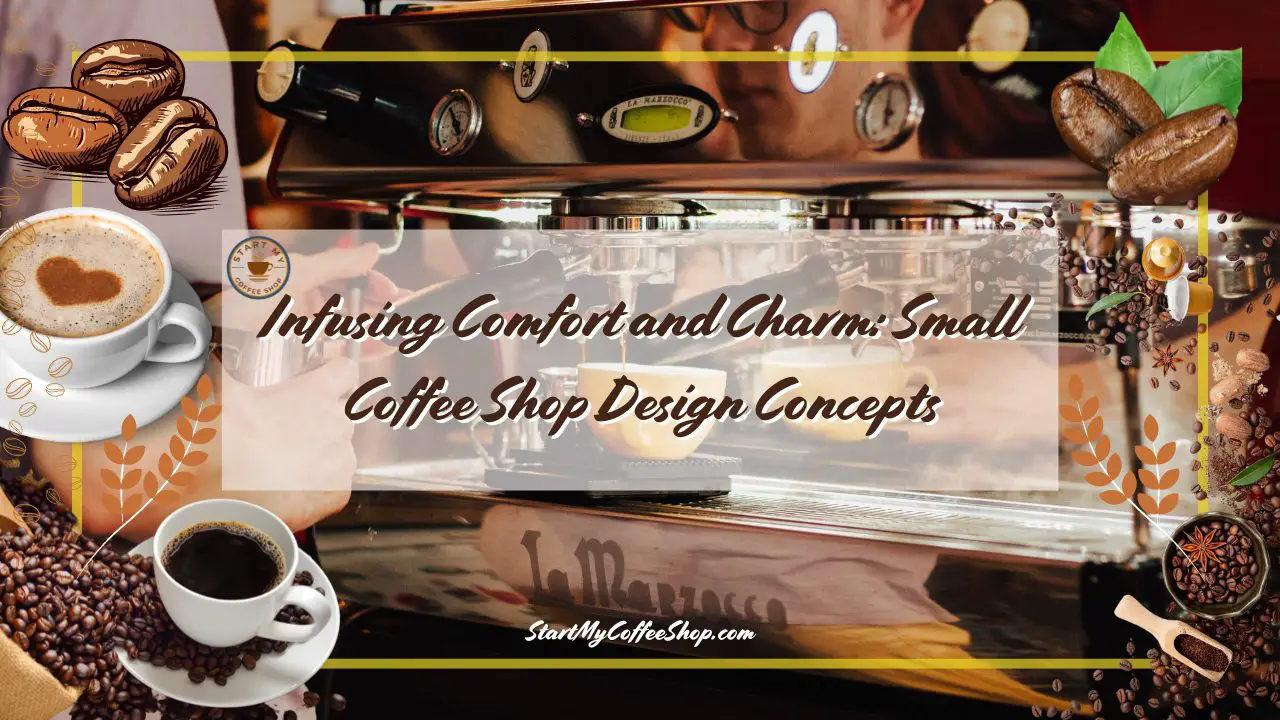Opening a coffee shop can be an exciting and thrilling venture for coffee enthusiasts and entrepreneurs alike. However, it’s essential to understand the various costs involved to ensure a good start.
The costs of starting a coffee shop typically include expenses such as rent, equipment, permits/licenses, furniture, inventory, marketing, staff wages, utilities, and initial stock.
From securing a location to purchasing equipment and hiring staff, this article will provide a comprehensive overview of the expenses you can expect when starting your coffee shop.
1. Location Costs:
 Rent is one of the primary expenses when securing a location for your coffee shop. The rental costs can vary greatly depending on factors such as the city’s popularity, the neighborhood’s foot traffic, and the overall demand for commercial spaces in the area. High-demand areas or prime locations may command higher rental prices, while more affordable options might be available in up-and-coming neighborhoods.
Rent is one of the primary expenses when securing a location for your coffee shop. The rental costs can vary greatly depending on factors such as the city’s popularity, the neighborhood’s foot traffic, and the overall demand for commercial spaces in the area. High-demand areas or prime locations may command higher rental prices, while more affordable options might be available in up-and-coming neighborhoods.
Leasehold improvements are another expense to consider. These are modifications or renovations you might need to make to the space to align it with your coffee shop’s design and functionality requirements. It could involve structural changes, interior upgrades, plumbing or electrical work, or installing specialized equipment. The extent of the improvements and their associated costs will depend on the condition of the space and your specific vision for the coffee shop.
When signing a lease agreement, landlords often require a security deposit, which serves as protection for any damages or unpaid rent. The amount of the security deposit can vary but is typically equivalent to a few months’ rent.
Property insurance is crucial to safeguard your investment. It protects your coffee shop and its assets from unforeseen events such as fire, theft, or natural disasters. The cost of property insurance will depend on factors such as the location, the size of the space, and the coverage you choose.
2. Equipment Costs:
 To deliver exceptional quality coffee and meet the expectations of your customers, it is imperative to make the right investments in equipment. The costs associated with acquiring the necessary equipment for a coffee shop can include a range of items, such as espresso machines, coffee grinders, brewing equipment, refrigeration units, blenders, and POS (Point of Sale) systems.
To deliver exceptional quality coffee and meet the expectations of your customers, it is imperative to make the right investments in equipment. The costs associated with acquiring the necessary equipment for a coffee shop can include a range of items, such as espresso machines, coffee grinders, brewing equipment, refrigeration units, blenders, and POS (Point of Sale) systems.
Espresso machines are the heart of any coffee shop, allowing you to craft rich and flavorful shots of espresso. Coffee grinders are equally important, as they ensure that your beans are freshly ground to perfection, enhancing the taste and aroma of each cup. Brewing equipment, such as pour-over devices or drip coffee makers, enables you to offer a variety of coffee brewing methods to cater to different preferences.
Refrigeration units are vital for storing milk, cream, and other perishable ingredients, ensuring they remain fresh and safe for consumption. Blenders are necessary for preparing popular blended coffee beverages, adding versatility to your menu offerings. Additionally, investing in a reliable POS system enables efficient order processing, inventory management, and smooth transaction handling.
When considering equipment costs, it is essential to thoroughly research and evaluate different brands and models. Look for equipment that is known for its durability, performance, and ease of maintenance. Balancing quality and budget is crucial, as investing in reliable equipment upfront can save you money in the long run by reducing repair and replacement costs.
3. Permits and Licenses:
Business licenses are necessary to legally operate your coffee shop. The costs associated with obtaining a business license can vary depending on the location and the type of establishment you plan to open.
Health permits are essential for maintaining a safe and hygienic environment in which to prepare and serve food and beverages. Costs for health permits are typically determined by factors such as the size of your coffee shop and the complexity of the menu offerings.
Food handling permits are another crucial requirement, ensuring that you and your staff follow proper food safety practices. The costs associated with food handling permits will depend on local regulations and the scope of your food preparation activities. If you plan to serve alcoholic beverages, you may need to obtain a liquor license, which often involves additional fees and compliance with specific regulations related to alcohol service.
It is essential to allocate a portion of your startup budget specifically for permits and licenses. Research the applicable regulations, gather the necessary documentation and be prepared to undergo inspections and approvals.
Failing to obtain the required permits and licenses can lead to penalties, fines, and even the closure of your coffee shop. By diligently adhering to local regulations and budgeting for these expenses, you can ensure a smooth and legally compliant operation from the outset.
Read more about Best Way to Clean Coffee Maker: Discovering the Most Effective Cleaning Technique
4. Interior Design and Furniture:
Crafting a warm and inviting ambiance is vital in captivating and retaining customers for your coffee shop. The costs associated with interior design and furniture can fluctuate depending on your chosen theme, style, and target demographic. When budgeting, consider expenses such as seating options, tables, lighting fixtures, decor elements, signage, and artwork, as they all contribute to the overall atmosphere.
The choice of seating plays a crucial role in determining the comfort and capacity of your coffee shop. Whether it’s cozy armchairs, communal tables, or a combination of seating styles, ensure they align with your envisioned atmosphere. Tables should be sturdy and practical, accommodating various group sizes and facilitating a seamless dining experience.
Lighting fixtures set the mood and enhance the aesthetic appeal. Consider a mix of natural light, pendant lights, or warm, soft lighting to create an inviting ambiance. Thoughtful decor elements, such as wall art, plants, or unique focal points, can add character and charm to your space.
Signage is essential for branding and wayfinding, helping customers navigate your coffee shop effortlessly. Invest in eye-catching and informative signage that aligns with your overall aesthetic.
To strike the right balance between aesthetics and functionality, carefully select furniture and decor that resonates with your target audience and reflects your brand identity. Keep in mind durability and ease of maintenance to ensure long-term value.
5. Inventory and Supplies:
Building and maintaining an inventory of essential supplies is a continual expense that coffee shop owners must consider. This inventory includes items such as coffee beans, teas, syrups, milk, pastries, and other ingredients required to serve your menu offerings. Determining the quantity and quality of these products is crucial and should be based on your menu selection and anticipated customer demand.
When budgeting for inventory costs, it’s essential to not only consider the price of the products themselves but also factor in additional expenses. Packaging materials, such as bags or containers for coffee beans, tea leaves, and pastries, contribute to the overall cost. Labels for packaged products may also need to be accounted for.
In addition, disposable cups, lids, napkins, stirrers, and other consumables are necessary for serving beverages and food to customers. These items should be included in your inventory budget, as their costs can accumulate over time. Be sure to assess the expected demand and consider bulk purchasing options to maximize cost savings.
Reviewing and adjusting your inventory levels and ordering practices can help minimize waste and control costs. Effective inventory management, along with a keen understanding of customer preferences, will allow you to strike the right balance between having enough stock to meet demand without excessive surplus.
6. Marketing and Advertising:
Allocating a dedicated budget for marketing and advertising is crucial in generating awareness and attracting customers to your coffee shop. Various costs are associated with implementing effective marketing strategies that can help establish your brand presence and drive customer engagement.
Creating a website is an important first step, enabling potential customers to discover your coffee shop online. The costs may include website development, hosting, and domain registration. Designing a captivating logo that reflects your brand identity is also a worthwhile investment, as it becomes a recognizable symbol associated with your business.
Printing menus, flyers, and other promotional materials is essential for offline marketing efforts. These materials can be distributed locally or displayed within your coffee shop to inform customers about your offerings and specials.
Embracing social media platforms and conducting targeted online advertising campaigns are effective ways to reach a broader audience. Social media promotions and online advertising costs will vary depending on the platforms and strategies employed.
Exploring traditional marketing strategies such as local print advertising, radio spots, or sponsoring community events can also be considered. Collaboration with local businesses, participating in fundraisers, or hosting community gatherings can enhance your brand visibility without incurring significant expenses.
Read more about Cheap Coffee Shop Counter Design: Affordable Inspirations for a Coffee Shop Counter Makeover
7. Staffing Expenses:
Ensuring you have a team of skilled and dedicated staff is paramount in delivering exceptional customer service and maintaining the smooth operation of your coffee shop. Staffing expenses encompass various factors, including wages, payroll taxes, benefits (if applicable), and training costs. It is important to budget for these expenses to attract and retain top talent.
Investing in experienced baristas who possess a deep understanding of coffee preparation and can create delightful beverages is essential. Friendly servers who can engage with customers and provide personalized service contribute to a positive dining experience. Hiring knowledgeable staff who share your passion for coffee and are enthusiastic about sharing their expertise can add value to the overall ambiance and customer satisfaction.
Aside from wages and benefits, training costs should be factored in to ensure that your staff is well-equipped to deliver consistent quality and adhere to your coffee shop’s standards. Training programs can cover areas such as coffee brewing techniques, customer service, menu knowledge, and health and safety protocols.
8. Utilities and Operating Costs:
Operating a coffee shop entails managing several utility expenses, including electricity, water, gas, and internet connectivity. Alongside these essential utilities, it is important to budget for additional expenses like cleaning supplies, maintenance and repairs, insurance coverage (such as liability insurance), and accounting services. Estimating and accounting for these ongoing costs is crucial to ensure the long-term profitability and sustainability of your coffee shop.
Electricity is a fundamental utility, powering various equipment such as coffee machines, refrigeration units, and lighting fixtures. Water is essential for brewing coffee, cleaning utensils, and maintaining a hygienic environment. Gas may be required for certain equipment or heating purposes, depending on your coffee shop’s setup. Reliable internet connectivity enables efficient communication, digital transactions, and online presence.
Cleaning supplies are necessary for maintaining cleanliness and hygiene standards, while periodic maintenance and repairs are essential to keep your equipment and premises in optimal condition. Insurance coverage, such as liability insurance, safeguards your coffee shop against unexpected events or claims.
Accounting services help you keep track of your financial records, taxes, and overall business performance. These services ensure accurate bookkeeping and help you make informed decisions regarding your coffee shop’s finances.
9. Initial Stock and Working Capital:
By estimating the anticipated demand and carefully planning your inventory, you can avoid shortages and fulfill customer orders promptly. Consider the variety of coffee beans and teas you plan to offer, as well as the quantity of pastries and ingredients needed for your menu. Factor in shelf life, storage requirements, and ordering lead times to maintain freshness and avoid wastage.
In addition to stocking up on inventory, setting aside enough working capital is essential to cover other initial operational expenses. These expenses may include rent, utilities, payroll, marketing, and licensing fees. Having adequate working capital ensures the smooth functioning of your coffee shop and provides a financial buffer during the early stages when revenue may be limited.
Summary
Starting a coffee shop requires careful financial planning and a realistic understanding of the costs involved. By considering expenses such as location, equipment, permits, furniture, inventory, marketing, staffing, utilities, and initial stock, you can create a comprehensive budget and increase your chances of growth.
Remember, it’s not just about serving great coffee but also about managing your resources efficiently. With proper preparation and a passion for coffee, your dream of owning a great coffee shop can become a reality.
Frequently Asked Questions
Question: How much does it cost to lease a location for a coffee shop?
Answer: The cost of leasing a location for a coffee shop can vary greatly depending on factors like the city, neighborhood, size of the space, and local demand.
Question: What equipment do I need to purchase for a coffee shop, and how much does it cost?
Answer: Essential equipment for a coffee shop includes espresso machines, coffee grinders, brewing equipment, refrigeration units, blenders, and POS systems. Costs for equipment can range from a few thousand dollars to tens of thousands.
Question: How much working capital should I have to cover initial expenses for a coffee shop?
Answer: It’s recommended to have several months’ worth of expenses, including rent, wages, inventory, and utilities, as a safety net. The exact amount will vary depending on your specific business plan and projected timeline for profitability.
To learn more on how to start your own coffee shop checkout my startup documents here
Please note: This blog post is for educational purposes only and does not constitute legal advice. Please consult a legal expert to address your specific needs.

Hi! I’m Shawn Chun
My adventure in coffee began when I first launched my first coffee shop back in the early 2000s. I had to figure out so many things on my own and to make it worse within 2 years of opening two large corporate coffee chains moved in just blocks away from me!
As I saw smaller and even some larger coffee shops in the neighborhood slowly lose customers to these giant coffee chains and slowly close up shop, I knew that I had to start getting creative…or go out of business.
I (like you may be) knew the coffee industry well. I could make the best latte art around and the foam on my caps was the fluffiest you have ever seen. I even had the best state-of-the-art 2 group digital Nuova Simonelli machine money could buy. But I knew that these things alone would not be enough to lure customers away from the name brand established coffee shops.
Eventually, through lots of trial and error as well as perseverance and creativity I did find a way to not only survive but also thrive in the coffee/espresso industry even while those corporate coffee chains stayed put. During those years I learned to adapt and always faced new challenges. It was not always easy, however, in the end, I was the sole survivor independent coffee shop within a 10-mile radius of my location. Just two corporate coffee chains and I were left after that year. All told the corporate coffee chains took down over 15 small independent coffee shops and kiosks and I was the last one standing and thriving.
Along the years I meet others with the same passion for coffee and I quickly learned that it is not only “how good a barista is” that makes a coffee shop successful, but the business side of coffee as well.
Hence why I started this website you are on now. To provide the tools and resources for up and coming coffee shop owners to gain that vital insight and knowledge on how to start a coffee shop successfully.
Stick around, browse through my helpful blog and resources and enjoy your stay! With lots of LATTE LOVE!
Shawn






